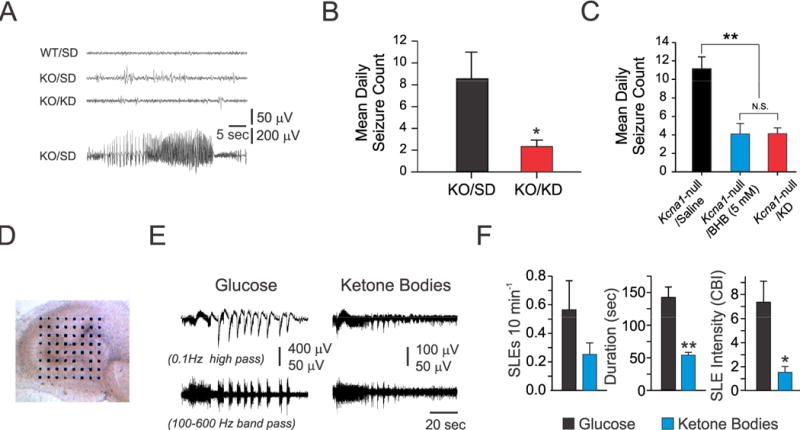Figure 1.

A ketogenic diet (KD) and ketone bodies (KB) provide anti-seizure effects in epileptic Kcna1-null (KO) mice. (A) Interictal (upper three traces) and ictal EEG (bottom trace) recordings from wild-type (WT) and KO mice treated with either standard rodent diet (SD) or a KD. The bottom trace (KO/SD) depicts an electrographic seizure coincident with a behavioral generalized tonic-clonic seizure (N=12 in each group). (B) Mean daily tonic-clonic seizure frequency in KO mice over 3-day recording period between SD-treated vs. KD-fed animals, *, p<0.05. (C) Mean daily seizure frequencies over a 3-day recording period in KO mice after a 10–14 day treatment with either BHB or saline. Chronic osmotic mini-pump administration of BHB resulted in anti-seizure effects. One-way ANOVA followed by Tukey test; **, p<0.01. (D-F) Long-term exposure to KB decreases seizure-like events (SLEs) in organotypic slice cultures of KO hippocampi. (D) Light microscopic view of a hippocampal slice culture (14 days in vitro [DIV]) on a 64-microelectrode array. (E) Representative SLEs from a slice cultured for two weeks with either normal glucose or KB (5 mM BHB and 1 mM ACA). High-frequency oscillations (HFOs) revealed by band-pass filtering were present during SLEs in both culture conditions (lower traces). (F) KB significantly reduced SLE duration (~67%) and intensity (~80%) (n=4 cultures harvested from three P3–5 mice per group, unpaired t-test: *, p<0.05; **, p<0.001). For panels (B, C and F), data points reflect the mean ± SEM.
